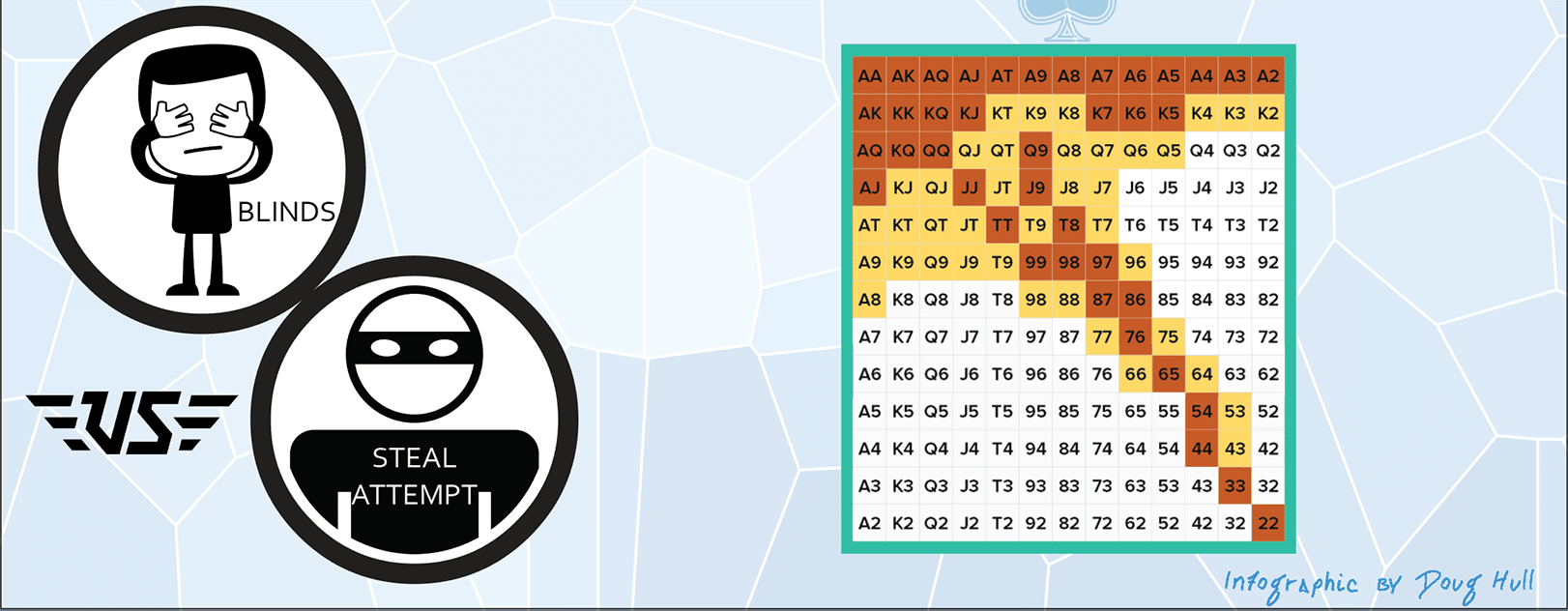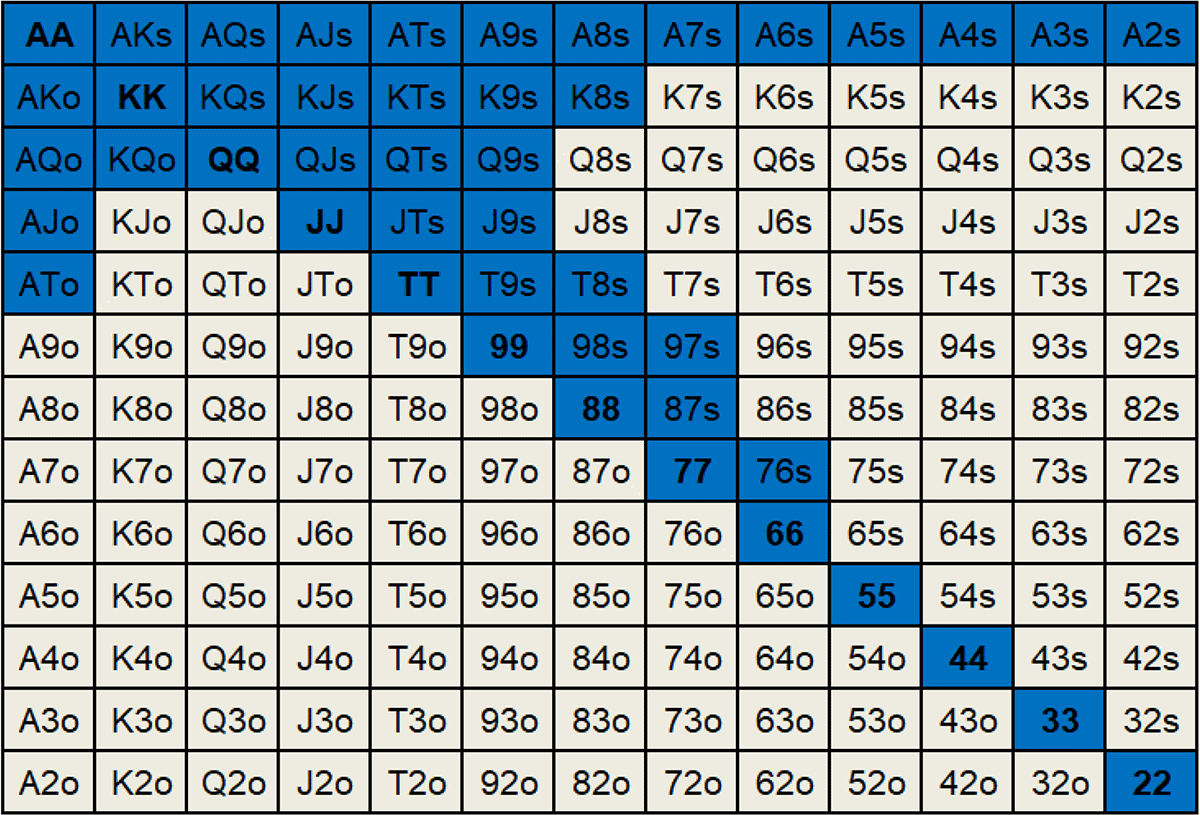Poker Blinds Chart
What are poker blinds ?
- This poker push fold chart gives you math-based guidelines for playing these situations. This strategy often prevails against opening and folding in tough games, even when playing as deep as 20 big blinds.
- In the poker chart below you see K-7 suited (suited = two cards of the same color, i.e. 3 of hearts and 7 of hearts) and you see that this hand can be played in late or middle position. Since you are the 6th player to the left of the dealer button, you are in middle position and can therefore play the hand.
- Get free heads up no limit holdem preflop charts for 100bb stacks. Learn a fundamentally sound strategy for which hands to raise, 3bet and more.
- This means that a tournament with a starting stack of T2,000 should have starting blinds at 10/20 at least and 25/50 at most. Blind increases. Blind increases are usually 50-100% of the last blind and the blind intervals are usually 20-30 minutes. Near the end of a tournament the big blind should be no larger than 2-4% of the average stack.
Based on the limit of the poker game the player to the left of the dealer’s button (small blind) and the player two to the left of the dealer (big blind) are required to place mandatory bets in the pot before cards are dealt (Small blind has to put half of the big blinds amount). These bets count toward the first round of betting. So if the pot is not raised pre-flop, small blind will only have to put half a bet to call and big blind has the option of raising or just checking.
In a poker tournament, blinds go up gradually. This is to ensure that the tournament finishes on a timely manner. (the higher the blinds get the more players tend to get eliminated).
Poker Buttons and Blinds. How to Play Poker. Buttons & Blinds. In button games, a non-playing dealer normally does the actual dealing.

Blinds usually go up after predetermined periods of time. (for example every 15 or 20 minutes).
Two main factors determine blind structure of the game:
- Starting chip amount
- How long you want the tournament to last.
Poker Blinds Chart Rows
Poker Blind Structure Tips


- The first big blind should be 1/50 of the starting chip amount. (or the starting chip amount should be 50 times the starting big blind). So if everyone starts with 1000 in chips the first big blind should be 10/20.
- Blind period is the time each blind lasts:
- Typical tournament blind periods are 10, 15, 20, 30, or 60 minutes.
- Blinds period should be the same for every blind.
- The faster the blind period is the faster the tournament ends and the more luck involves. So it’s a good idea to have slightly longer blind periods at your house game. 15 or 20 minute blind periods are good choices. Blinds in online websites tend to go up faster. This is because online poker action is much faster than live poker.
- Blinds typically double after each round. If the first big blind is 10/20, the next one should be 20/40.
Calculate Blind Structure
Follow these simple steps to create blind structure that best fits your game:
- Decide your starting chip amount.
- Divide it by 50. This should be your first big blind.
- Make your final big blind (when the tournament should finish) equal to your starting chip amount.
- Arrange the middle level blinds so that they gradually increase from your first big blind to the last one. It is best to keep the first couple blind periods low.
- Add the period (times) together. If it seems too long takes couple levels off the chart, and if it seems short add couple level to the chart.
Sample Tournament Blind Structure Chart
Poker Blinds Chart Sheet
Following is a chart of recommended blind structures based on different starting chip stacks :
Poker Blinds Chart Free
| Blind Period | Chip Stack | |||
| 100 | 1000 | 2500 | 5000 | |
| 1 | 1/2 | 10/20 | 25/50 | 50/100 |
| 2 | 2/4 | 20/40 | 50/100 | 100/200 |
| 3 | 3/6 | 30/60 | 75/150 | 150/300 |
| 4 | 5/10 | 50/100 | 100/200 | 200/400 |
| 5 | 10/20 | 75/150 | 200/400 | 300/600 |
| 6 | 15/30 | 100/200 | 300/600 | 500/1000 |
| 7 | 25/50 | 150/300 | 500/1000 | 750/1500 |
| 8 | 50/100 | 200/400 | 750/1500 | 1000/2000 |
| 9 | 75/150 | 300/600 | 1000/2000 | 1500/3000 |
| 10 | 100/200 | 400/800 | 1500/3000 | 2000/4000 |
| 11 | 150/300 | 500/1000 | 2000/4000 | 3000/6000 |
| 12 | 200/400 | 1000/2000 | 2500/5000 | 5000/10000 |